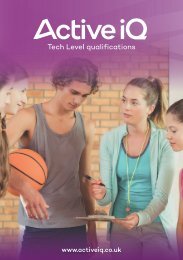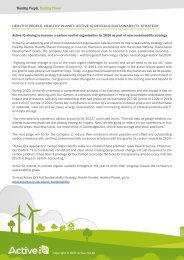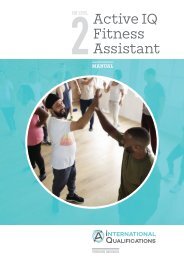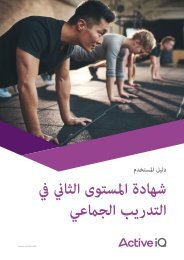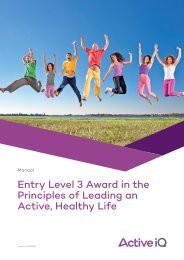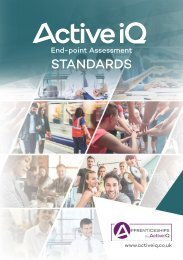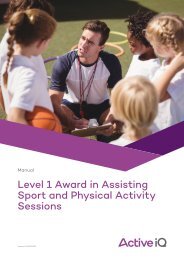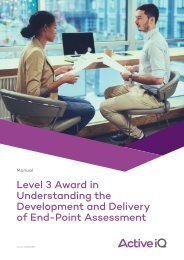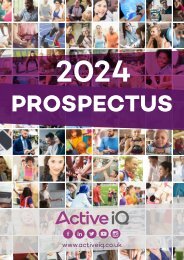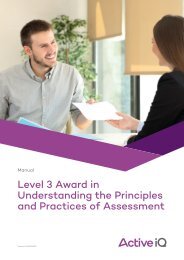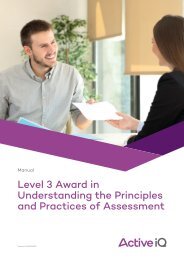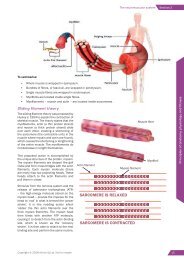Active IQ Level 2 Award in Leading Physical Activity for Adolescents (sample manual)
For more information, please visit https://activeiq.co.uk/qualifications/level-2/active-iq-level-2-award-in-leading-physical-activity-for-adolescents
For more information, please visit https://activeiq.co.uk/qualifications/level-2/active-iq-level-2-award-in-leading-physical-activity-for-adolescents
You also want an ePaper? Increase the reach of your titles
YUMPU automatically turns print PDFs into web optimized ePapers that Google loves.
Manual<br />
<strong>Level</strong> 2 <strong>Award</strong> <strong>in</strong><br />
Lead<strong>in</strong>g <strong>Physical</strong><br />
<strong>Activity</strong> <strong>for</strong><br />
<strong>Adolescents</strong><br />
Version A<strong>IQ</strong>005694
The stages of adolescent development<br />
Section 1<br />
Section 1: The stages of<br />
adolescent development<br />
Assessment criteria<br />
By the end of this section you will be able to:<br />
• Describe the three stages of adolescence<br />
• Summarise the characteristics of physical development <strong>in</strong> adolescents<br />
• Summarise the characteristics of mental and emotional development of adolescents<br />
Introduction<br />
Adolescence refers to the period of human growth that occurs between childhood and adulthood.<br />
Age is a convenient way to def<strong>in</strong>e the three adolescent stages as it is often the most appropriate way of assess<strong>in</strong>g and<br />
compar<strong>in</strong>g the biological changes that take place. It must be remembered that age is only one of the characteristics<br />
that del<strong>in</strong>eates this period of development.<br />
Currently, accord<strong>in</strong>g to the World Health Organization (WHO), and as adopted by the UK government, adolescence<br />
refers to a young person aged between 10 and 19 years. This age range falls with<strong>in</strong> WHO’s def<strong>in</strong>ition of young<br />
people, which refers to <strong>in</strong>dividuals between the ages of 10 and 24.<br />
The period of adolescence is divided <strong>in</strong>to three stages:<br />
1. Early adolescence: ages 10–15<br />
• <strong>in</strong>cludes pubertal and cognitive changes<br />
• start of sexual curiosity<br />
• relationships with close friends become more important<br />
2. Middle adolescence: ages 14–17<br />
• a time of <strong>in</strong>creased <strong>in</strong>dependence and experimentation<br />
• <strong>in</strong>dividuals start to be concerned about how they look, body image and what<br />
others th<strong>in</strong>k, worry<strong>in</strong>g about their sexual attractiveness<br />
• focus on peer groups becomes more <strong>in</strong>tense<br />
• <strong>in</strong>dividuals become more <strong>in</strong>dependent<br />
• feel<strong>in</strong>g <strong>in</strong>v<strong>in</strong>cible and risk-tak<strong>in</strong>g is significantly <strong>in</strong>creased dur<strong>in</strong>g this stage<br />
3. Late adolescence: ages 16–19<br />
• adolescents make important personal and vocational decisions<br />
• a time of transition to university, the world of work or tak<strong>in</strong>g a<br />
gap year<br />
<strong>Physical</strong> activity, health and development considerations <strong>for</strong> adolescents<br />
These stages provide a useful context <strong>for</strong> understand<strong>in</strong>g body image issues<br />
and the concerns of adolescents, as well as a framework <strong>for</strong> provid<strong>in</strong>g them<br />
with <strong>in</strong><strong>for</strong>mation they need to participate <strong>in</strong> physical activity and practise<br />
healthy eat<strong>in</strong>g behaviours.<br />
ACTIVITY<br />
Read the article at https://www.bbc.co.uk/news/health-42732442 (Jan 2018)<br />
Why is a change <strong>in</strong> the def<strong>in</strong>ition of adolescence required, accord<strong>in</strong>g to scientists report<strong>in</strong>g <strong>in</strong> the<br />
Lancet Child & Adolescent Health journal?<br />
What are the implications <strong>for</strong> physical activity professionals?<br />
Copyright © 2019 <strong>Active</strong> <strong>IQ</strong> Ltd. Not <strong>for</strong> resale 3
Section 2<br />
Childhood obesity and how to assess it<br />
The statistics of childhood obesity <strong>in</strong> the UK<br />
The most recent statistics released by Public Health England as part of the Government’s National Child Measurement<br />
Programme (NCMP) <strong>for</strong> England, 2017–18, cover<strong>in</strong>g the school years Reception and Year 6, are as follows:<br />
For Year 6 (10–11 years)<br />
• Obesity prevalence <strong>in</strong>creased from 20.0% <strong>in</strong> 2016/17 to 20.1% <strong>in</strong> 2017/18.<br />
• Obesity prevalence was higher <strong>in</strong> boys than girls.<br />
• Obesity prevalence <strong>for</strong> children liv<strong>in</strong>g <strong>in</strong> the most deprived areas was more than double that of those liv<strong>in</strong>g<br />
<strong>in</strong> the least deprived areas.<br />
• One <strong>in</strong> three children leav<strong>in</strong>g primary school were either overweight or obese.<br />
Year 6- children leav<strong>in</strong>g primary school<br />
Underweight Healthy weight Overweight Obese Severly Obese<br />
UK government plan to tackle childhood obesity<br />
The UK government set out to implement a plan to tackle childhood obesity, know<strong>in</strong>g the huge impact it has on<br />
life expectancy and physical and mental health conditions, and the great economic cost to the UK of ignor<strong>in</strong>g the<br />
problem. In later sections we will be look<strong>in</strong>g at understand<strong>in</strong>g nutritional needs and physical activity identifi ed with<strong>in</strong><br />
the plan. Below is a quote from the plan:<br />
Obesity is a complex problem with many drivers, <strong>in</strong>clud<strong>in</strong>g our behaviour,<br />
environment, genetics and culture. However, at its root obesity is caused by an<br />
energy imbalance: tak<strong>in</strong>g <strong>in</strong> more energy through food than we use through activity.<br />
ACTIVITY<br />
Internet activity: Read the article ‘Tenfold <strong>in</strong>crease <strong>in</strong> childhood and adolescent obesity <strong>in</strong> four<br />
decades: new study by Imperial College London and WHO’, published <strong>in</strong> October 2017: https://www.<br />
who.<strong>in</strong>t/news-room/detail/11-10-2017-tenfold-<strong>in</strong>crease-<strong>in</strong>-childhood-and-adolescent-obesity-<strong>in</strong>-fourdecades-new-study-by-imperial-college-london-and-who<br />
The headl<strong>in</strong>e reads: ‘World will have more obese children and adolescents than underweight by 2022’.<br />
• What are the issues that are be<strong>in</strong>g l<strong>in</strong>ked to this <strong>in</strong>crease?<br />
• What plans and <strong>in</strong>itiatives are be<strong>in</strong>g put <strong>in</strong> place to help reduce childhood and adolescent obesity<br />
<strong>in</strong> the UK? Are they hav<strong>in</strong>g any impact yet?<br />
Further research<br />
Look up the most up-to-date UK BMI statistics and note the trends over the last 10 years. The current<br />
report, published <strong>in</strong> July 2018, can be found at:<br />
https://app.box.com/s/og3q86aqejc99okxe9xyvpfvo21xai21/fi le/306723044116<br />
8<br />
Copyright © 2019 <strong>Active</strong> <strong>IQ</strong> Ltd. Not <strong>for</strong> resale
Section 3<br />
Physiology – The changes and effects of physical activity <strong>in</strong> adolescents<br />
Bones grow and harden at different speeds. For example, long bones may take until the early 20s to fully develop,<br />
while the bones <strong>in</strong> the foot may be fully grown and ossified by the age of 10.<br />
Fetus:<br />
months<br />
Fetus: at 2-3<br />
months<br />
Childhood<br />
Adolescence<br />
Cartilage<br />
growth plate<br />
Blood<br />
vessel<br />
Cavity<br />
Compact bone<br />
conta<strong>in</strong><strong>in</strong>g<br />
osteocytes<br />
cartilage<br />
model<br />
<strong>for</strong>ms<br />
Compact bone<br />
develops<br />
start<strong>in</strong>g at<br />
primary<br />
site<br />
Spongy bone<br />
develops at<br />
secondary<br />
sites<br />
The growth<br />
plates<br />
promote<br />
longitud<strong>in</strong>al<br />
growth<br />
until young<br />
adulthood<br />
Cartilage<br />
growth plate<br />
The development of bone throughout childhood<br />
There are only m<strong>in</strong>or differences between adult male and female skeletons once fully grown and ossified:<br />
• Generally, male bones tend to be heavier than the correspond<strong>in</strong>g female bones.<br />
• Females have a greater carry<strong>in</strong>g angle at the elbow jo<strong>in</strong>t, a smaller femoral head at the hip jo<strong>in</strong>t and a wider<br />
pelvis to accommodate childbirth.<br />
Lifestyle factors affect<strong>in</strong>g bone growth<br />
Bone is a liv<strong>in</strong>g tissue and will cont<strong>in</strong>ue to be renewed and change shape and size throughout life. Bone mass<br />
<strong>in</strong>creases until the early 20s when peak bone mass is achieved.<br />
‘Dur<strong>in</strong>g childhood, adolescence and early adulthood, your skeleton is grow<strong>in</strong>g, and<br />
it is vitally important to maximise bone strength. If you ‘bank’ plenty of bone <strong>in</strong><br />
these years, your skeleton will be <strong>in</strong> a better position to withstand the loss of bone<br />
strength that occurs with advanc<strong>in</strong>g age.’ (National Osteoporosis Society 2018)<br />
Factors that can affect bone growth and lead to bone dem<strong>in</strong>eralisation or osteoporosis are poor nutrition, smok<strong>in</strong>g<br />
and <strong>in</strong>activity. It is essential that, as <strong>in</strong> childhood, through adolescent and early adulthood healthy habits are<br />
adopted to help prevent future structural problems with<strong>in</strong> the bony framework. These healthy habits <strong>in</strong>clude:<br />
• Eat<strong>in</strong>g a well-balanced and calcium-rich diet.<br />
• Tak<strong>in</strong>g part <strong>in</strong> physical activity of moderate <strong>in</strong>tensity.<br />
• Includ<strong>in</strong>g appropriate weight-bear<strong>in</strong>g exercises as part of an exercise programme.<br />
• Positive lifestyle habits such as not smok<strong>in</strong>g or dr<strong>in</strong>k<strong>in</strong>g excessive alcohol.<br />
18<br />
Copyright © 2019 <strong>Active</strong> <strong>IQ</strong> Ltd. Not <strong>for</strong> resale
Section 3<br />
Physiology – The changes and effects of physical activity <strong>in</strong> adolescents<br />
Osteochondritis<br />
Causes<br />
This is a pa<strong>in</strong>ful condition where the cartilage and bone <strong>in</strong><br />
a jo<strong>in</strong>t are <strong>in</strong>fl amed. It often presents as osteochondritis<br />
dissecans (OCD).<br />
The term dissecans refers to the creation of a fl ap of cartilage<br />
that breaks away from its underly<strong>in</strong>g subchondral attachments.<br />
Weight tra<strong>in</strong><strong>in</strong>g too early, be<strong>in</strong>g obese and excessive weightbear<strong>in</strong>g<br />
activities can lead to this condition.<br />
It can occur <strong>in</strong> the knees (around 75% of cases), hips, ankles<br />
and sp<strong>in</strong>e.<br />
This problem is more likely dur<strong>in</strong>g the growth spurt. However,<br />
because adolescent bones are still grow<strong>in</strong>g, they are more<br />
likely than adults to recover from OCD.<br />
Symptoms<br />
Articular<br />
Cartilage<br />
Femur<br />
Tibia<br />
Osteochondritis<br />
Dissecans<br />
OCD usually causes swell<strong>in</strong>g and pa<strong>in</strong> <strong>in</strong> the affected jo<strong>in</strong>t, which catches and locks dur<strong>in</strong>g movement.<br />
Treatment and recovery<br />
Follow<strong>in</strong>g diagnosis via an X-ray, the problem may be treated <strong>in</strong>volv<strong>in</strong>g modifi cation of activity <strong>for</strong> 6–12 weeks to<br />
promote bone heal<strong>in</strong>g. In those patients who have fragments detached then surgery will be required to remove<br />
the fragments. Post-operative rehabilitation often <strong>in</strong>volves low-impact activities such as walk<strong>in</strong>g or swimm<strong>in</strong>g. If<br />
untreated it can lead to the development of arthritis.<br />
Scoliosis<br />
This is defi ned as a lateral curvature of the<br />
sp<strong>in</strong>e, the presence of which is abnormal.<br />
Causes and symptoms<br />
There is a defi nite genetic <strong>in</strong>fl uence,<br />
with around 25% of those with scoliosis<br />
hav<strong>in</strong>g a direct relative with a curvature.<br />
Neuromuscular conditions such as cerebral<br />
palsy and muscular dystrophy have been<br />
found to be the cause of more rare scoliosis<br />
diagnosis, as well as birth defects such as<br />
sp<strong>in</strong>a bifi da, which effects the development<br />
of bones <strong>in</strong> the sp<strong>in</strong>e.<br />
Diagnosis<br />
When the sp<strong>in</strong>e bends to the side, the vertebrae become twisted and pull the ribs around with them. This can<br />
sometimes be seen as a ‘bulge’ <strong>in</strong> the back and/or prom<strong>in</strong>ent shoulder blade.<br />
Most sp<strong>in</strong>al curvatures may be of either early onset, be<strong>for</strong>e the age of 7 years, or late onset, usually <strong>in</strong> adolescence –<br />
particularly dur<strong>in</strong>g the growth spurt. Although there is no notable difference <strong>in</strong> the diagnosis of mild scoliosis between<br />
boys and girls, girls have been found to suffer more from severe sp<strong>in</strong>al curvatures and require more treatment.<br />
Treatment and recovery<br />
Scoliosis is quite common. About three or four children per thousand of the general population will need specialist<br />
supervision as a result of a sp<strong>in</strong>al scoliosis, and about one child <strong>in</strong> every thousand will need corrective surgery.<br />
The earlier the condition is diagnosed, the better the chances of satisfactory long-term results from physiotherapy.<br />
22<br />
Copyright © 2019 <strong>Active</strong> <strong>IQ</strong> Ltd. Not <strong>for</strong> resale
ADOLESCENCE<br />
is the period of growth between<br />
CHILDHOOD<br />
EARLY<br />
ADOLESCENCE: AGES 10–15<br />
MIDDLE<br />
ADOLESCENCE: AGES 14–17<br />
LATE<br />
ADOLESCENCE: AGES 16–19<br />
and<br />
ADULTHOOD<br />
THE GROWTH<br />
SPURT<br />
BONE GROWTH<br />
MUSCLE &<br />
FAT TISSUE<br />
CHANGES<br />
- GROWTH-PLATE<br />
FRACTURES<br />
- SEVER’S DISEASE<br />
- OSGOOD-SCHLATTER’S<br />
DISEASE<br />
- OSTEOCHONDRITIS<br />
- SCOLIOSIS<br />
GROWTH-RELATED INJURIES AND CONDITIONS<br />
- SCHEUERMANN’S<br />
DISEASE<br />
INCREASE IN<br />
TESTOSTERONE (BOYS)<br />
AND OESTROGEN (GIRLS)<br />
Copyright © 2019 <strong>Active</strong> <strong>IQ</strong> Ltd. Not <strong>for</strong> resale
The legal and professional requirements <strong>for</strong> lead<strong>in</strong>g physical activity sessions<br />
Section 1<br />
How to ma<strong>in</strong>ta<strong>in</strong> professional boundaries when work<strong>in</strong>g<br />
with adolescents<br />
As physical activity professionals, we are <strong>in</strong> a privileged position and will often be <strong>in</strong> contact with children and young<br />
people with<strong>in</strong> a physical environment/sett<strong>in</strong>g. Our role is to motivate and encourage them to participate <strong>in</strong> physical<br />
activities, to have fun through build<strong>in</strong>g positive relationships and a rapport with the <strong>in</strong>dividuals and do<strong>in</strong>g noth<strong>in</strong>g<br />
that will harm them.<br />
To ma<strong>in</strong>ta<strong>in</strong> these professional boundaries when work<strong>in</strong>g with adolescents, we need to consider the relevant legal<br />
responsibilities we have and ensure we adhere to them:<br />
• Safeguard<strong>in</strong>g children and vulnerable young adults – safeguard<strong>in</strong>g is the action that is taken to promote<br />
the welfare of children and vulnerable young adults and protect them from harm.<br />
• Duty of Care is ‘a moral and legal obligation to ensure the safety or well-be<strong>in</strong>g of others.’<br />
• In loco parentis is the Lat<strong>in</strong> <strong>for</strong> ‘<strong>in</strong> place of a parent’ and refers to the legal responsibility of a person and/or<br />
organisation to take on some of the functions and responsibilities of a parent.<br />
As a physical activity professional, it is important to understand and apply safe work<strong>in</strong>g practise <strong>in</strong> relation to each<br />
of the follow<strong>in</strong>g:<br />
SAFE WORK AREA AND<br />
PRACTICE<br />
Are there current risk assessments<br />
<strong>in</strong> place <strong>for</strong> the area and activities<br />
specific to the age group you<br />
are work<strong>in</strong>g with? Appropriate<br />
adaptations should be used when<br />
work<strong>in</strong>g with specialist groups.<br />
SITE PROCEDURES<br />
Are you aware of the specific site<br />
procedures you are work<strong>in</strong>g <strong>in</strong> and<br />
the report<strong>in</strong>g procedures <strong>for</strong> the<br />
specific age group you are work<strong>in</strong>g<br />
with? This will <strong>in</strong>clude follow<strong>in</strong>g<br />
organisational procedures<br />
related to safeguard<strong>in</strong>g, report<strong>in</strong>g<br />
procedures and <strong>in</strong>cidents.<br />
EQUIPMENT<br />
Is there the correct equipment/<br />
size of equipment available <strong>for</strong><br />
the specific age group you are<br />
work<strong>in</strong>g with? Ensure equipment is<br />
clean and stored at an appropriate<br />
height <strong>for</strong> users.<br />
NUMBERS AND REGISTERS<br />
Have you got a register or sign<strong>in</strong>g-<strong>in</strong><br />
procedure <strong>for</strong> the specific age group<br />
you are work<strong>in</strong>g with? Do you have the<br />
necessary <strong>in</strong><strong>for</strong>mation about the child or<br />
young person, and has parental consent<br />
been given <strong>for</strong> photographs, adm<strong>in</strong>ister<strong>in</strong>g<br />
first aid or medication?<br />
STORING AND SHARING OF<br />
PERSONAL DATA<br />
Is the personal <strong>in</strong><strong>for</strong>mation provided<br />
about the child or young person stored<br />
securely? Is confidentiality adhered to so<br />
that only authorised staff can access it on<br />
a ‘need to know’ basis, <strong>in</strong> l<strong>in</strong>e with Data<br />
Protection legislation (GDPR)?<br />
PERSONAL SAFETY<br />
Hold<strong>in</strong>g appropriate qualifications <strong>for</strong><br />
the session delivered and only work<strong>in</strong>g<br />
with participants <strong>for</strong> which you are<br />
qualified and ma<strong>in</strong>ta<strong>in</strong><strong>in</strong>g CPD. Is correct<br />
public liability <strong>in</strong>surance <strong>in</strong> place? Who<br />
is the duty first aider and where is the<br />
nearest contact phone and first aid kit?<br />
Programm<strong>in</strong>g safe and effective physical activity <strong>for</strong> adolescents<br />
It is essential that professional boundaries are ma<strong>in</strong>ta<strong>in</strong>ed. There are some key ‘do’s and don’ts’ to ensure all<br />
participants and physical activity professionals are kept safe and organisational safeguard<strong>in</strong>g policies and<br />
procedures are followed.<br />
DO:<br />
Ensure you have correct contact details of the child and<br />
emergency contact details.<br />
Always use appropriate language and behaviour and<br />
challenge any discrim<strong>in</strong>atory or offensive behaviour.<br />
DON’T:<br />
Store participants’ details on your own personal<br />
phone (if you are self-employed then have a work and<br />
personal phone).<br />
L<strong>in</strong>k to participants’ Facebook or other social network<br />
sites.<br />
Use hurtful, disrespectful comments or ignore other<br />
participants’ comments.<br />
Copyright © 2019 <strong>Active</strong> <strong>IQ</strong> Ltd. Not <strong>for</strong> resale 77
Select<strong>in</strong>g suitable activities<br />
Section 5<br />
Suitable types of equipment<br />
The still develop<strong>in</strong>g bodies of young people mean that adult equipment is not always the most suitable <strong>in</strong> terms of<br />
produc<strong>in</strong>g a functional range of movement <strong>in</strong> a young adolescent.<br />
The physical activity professional should be able to judge whether the equipment they are work<strong>in</strong>g with is the correct<br />
size and shape to ensure safety and effectiveness <strong>for</strong> the adolescent <strong>in</strong> question. If the equipment is deemed as<br />
unsuitable <strong>in</strong> proportion, an alternative exercise is required.<br />
Listed below is the typical equipment used <strong>in</strong> a group physical activity environment which is suitable <strong>for</strong> adolescent<br />
use.<br />
Fitness equipment<br />
Steps<br />
Medic<strong>in</strong>e balls<br />
Hand weights<br />
Stability balls<br />
Wobble boards and bosu’s<br />
Barbells and dumbbells<br />
Programm<strong>in</strong>g safe and effective physical activity <strong>for</strong> adolescents<br />
Resistance bands<br />
Indoor bikes<br />
Copyright © 2019 <strong>Active</strong> <strong>IQ</strong> Ltd. Not <strong>for</strong> resale 101



